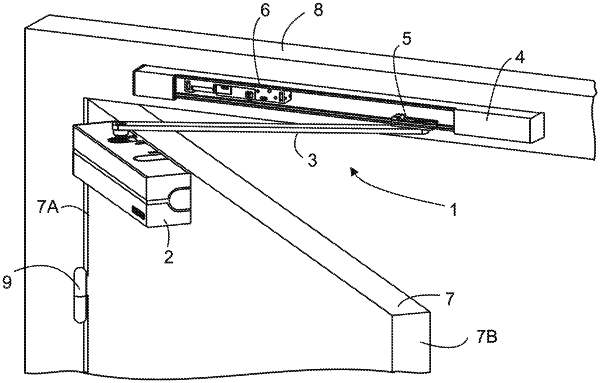| CPC E05F 3/222 (2013.01) | 21 Claims |

|
1. A hold-open arrester arrangement for a door closer and slide rail having a hold-open function to hold a door open, and having an electric release arrangement arranged to release the hold-open function in a fire alarm situation, wherein the hold-open arrester arrangement comprises:
a sliding block connectable with a slide rail in a sliding manner and also pivotably connectable to an arm of a door closer, the sliding block comprising:
a support surface; and
a pivoted lever having a front surface and a back surface, the pivoted lever being spring biased towards a locking position where the front surface is in contact with the support surface; and
an arrester unit connectable to the slide rail and having a body, the electric release arrangement, and said hold-open function with the sliding block, the body having a front end and a rear end, the arrester unit comprising:
a locking lever having a cam;
a slide element spring-biased towards an arresting position of the slide element, the slide element at the arresting position being arranged to keep the locking lever at a holding location, the cam being out of the body at the holding location; and
an overload lever,
wherein the pivoted lever is arranged to turn due to the cam when the sliding block is passing the arrester unit towards the rear end of the arrester unit, the pivoted lever also arranged to turn back to the locking position after passing the cam whereby the arrester unit providing said hold-open function due to the cam being out of the body, the sliding block being also capable of sliding toward the rear end of the arrester unit,
wherein the electric release arrangement is arranged to move the slide element towards the rear end in case of fire alarm whereby releasing said locking lever from the holding location allowing the sliding block to move away from the arrester unit by passing the front end of the arrester unit, and
wherein the overload lever is arranged to turn from its normal position in case a force from the sliding block affecting to the overload lever via the locking lever is greater than a threshold force value, the turning of the overload lever allowing the locking lever move towards a front end of the arrester unit, and to turn out of way of the sliding block, thereby allowing the movement of the sliding block away from the arrester unit, said threshold force value being depend on a holding spring that is arranged to bias the overload lever to the normal position.
|